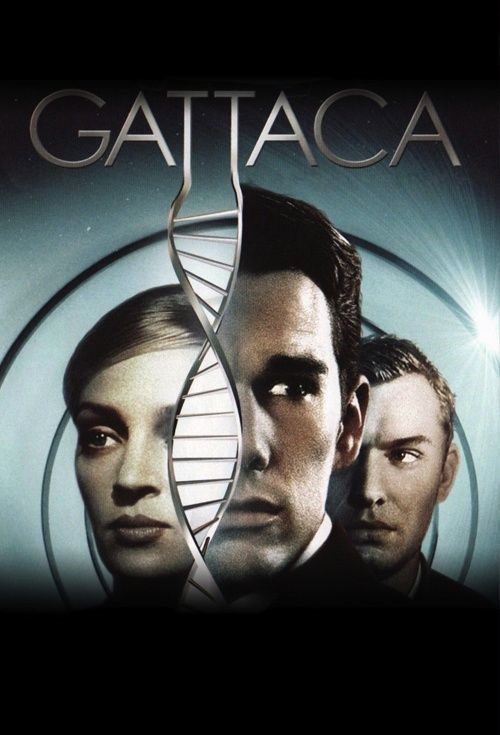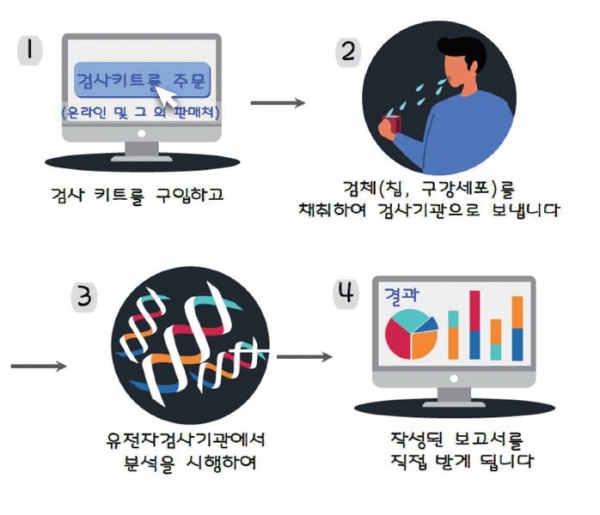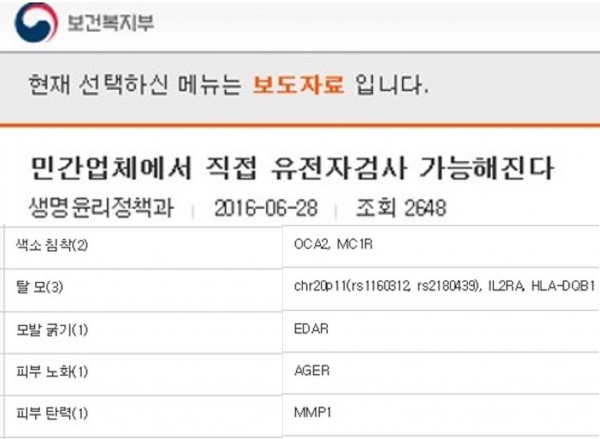Prof. Park, Byungchul
Dankook University Medical School Dermatology Class

Introduction
The 1997 film "GATTACA" analyzes every gene with a drop of blood in the near future, predicting a person's likelihood of developing diseases and mortality(Figure 1).
Will this world ever come? There are many things that the imagination in the movie is becoming a reality through the 4th industrial revolution, so we can fully think that there is a possibility for this world. In particular, in 2018, Johns Hopkins University in the U.S. introduced a technology that could screen various cancers with a drop of blood (Figure 2).

Androgenic hair loss is known to have a significant effect on genetic factors, as it is named as an androgenetic alopecia.
Thus, to treat and identify the cause of androgenic hair loss, many medical researchers attempted genetic approaches from the early stages, unlike other skin diseases. This is due to the discovery of the double helix structure of individual DNA in the 1950s, and the development of genetics and genomics, in particular, led to the completion of the Human Genome Project in 2003 and the sequencing of human genes. Since the 2000s, genetic sequencing has been combined with digital technology, and the so-called NGS(Next Generation Sequencing) has attracted more attention. The genetic approach to the cause of hair loss became more active along with the development of genetic analysis technologies, leading to some significant consequences of androgenic hair loss and associated gene relationships.
Body
1) Meaning and limitations of individual genetic analysis
In personalized genetic analysis, the term "Direct to Consumer" is frequently mentioned. Direct To Consumer DTC (Figure 3); In genetic testing, a consumer receives a genomic analysis kit directly from a genetic company, collects epithelial cells in the mouth, sends them to a courier, etc. without a prescription from a disease or doctor. However, in these DTC services, not all genes can be analyzed because human genes are individual's unique information, but only genes approved and disclosed by the government can be analyzed.

1) Buys diagnosis kit. 2) Collects a sample(saliva, epithelial cell) to the testing center. 3) DNA testing center analyses. 4) Send a report to the individuals.
In 2016, the Ministry of Health and Welfare allowed DTC gene services for certain diseases in the background of future new industry drivers and excavations in the era of the Fourth Industrial Revolution and the Genome Revolution [3] 45 genes of the first 11 items were allowed. In the dermatological area, genetic testing is possible for hair loss, pigmentation, hair thickness, skin aging, skin elasticity, etc. (Figure 4). In 2020, the Ministry of Health and Welfare announced that four licensed genomic institutions could provide genetic DTC services in 56 categories (Figure 5).[3] However, if you look closely at the hair loss area, the published genes include chr20p11(rs1160312, rs2180439), IL2RA, HLA-DQ14, and EDAR genes for hair thickness. However, a closer look at this gene, two genes located in chromosome 20p 11 are known to be significantly mutated in androgenic hair loss in many studies, and IL2AR and HLA-DQB1 are associated with circular hair loss. The EDAR gene, known for its hair thickness, is associated with premature androgenic hair loss. If you look at it like this, let me know the current DTC. There are only three genes associated with androgenic hair loss. The combination of these three genetic mutations alone is virtually low in sensitivity and specificity to fully diagnose or predict androgenic hair loss. These genes are also derived from foreign studies, which may vary differently in Korea. For example, the genetic site of EDA2R is located close to the androgen receptor on the sex chromosome, X. However, in Korea, the small alternative gene frequency Minor allele frequency of androgen receptor androgen polymorphism with EDAR2R is too low for Western countries, so this mutation is meaningless to apply to Koreans. Therefore, the current DTC genetic testing for hair loss is still in its infancy, and it should be recognized that its application is limited(Figure 5). In addition, items related to the diagnosis and treatment of diseases are not permitted by genetic testing, and Article 46 of the Bioethics and Safety Act stipulates the prohibition of discrimination by genetic information and should not be exploited in various social settings.


The interpretation of the results also indicates that genetic testing is several times more likely to lead to certain diseases such as hair loss or aging, which is only a statistical study of many subjects, suggesting genetic possibilities among different risk factors, and therefore cannot be accepted as a fateful result.
2) The latest research for early hair loss diagnosis based on genes
Earlier, we looked at the utilization, expansion and limitations of DTC's to match the gene age. Now, we are going to look at the latest studies to see if early diagnosis and predict gene-based hair loss in practical medical aspects is possible.
Since 2010, a number of previous studies have conducted a number of studies to determine what the gene prediction for androgenic hair loss is, by collecting genetic mutations known to be associated with androgenic hair loss.[4-6]
The discovery of genes associated with androgenic hair loss in individual studies is based on the Genome Wide Association Study, which identifies the statistical significance of mutant genes and finds hair loss-related genes. Some of the most well-known causes associated with hair loss include HDAC9, 20p11 (5 mutations) and AR/EDA2Rlocus (3 mutations).2) The latest research for early hair loss diagnosis based on genes
Earlier, we looked at the utilization, expansion and limitations of DTC's to match the gene age. Now, we are going to look at the latest studies to see if early diagnosis and predict gene-based hair loss in practical medical aspects is possible.
Since 2010, a number of previous studies have conducted a number of studies to determine what the gene prediction for androgenic hair loss is, by collecting genetic mutations known to be associated with androgenic hair loss.[4-6]
The discovery of genes associated with androgenic hair loss in individual studies is based on the Genome Wide Association Study, which identifies the statistical significance of mutant genes and finds hair loss-related genes. Some of the most well-known causes associated with hair loss include HDAC9, 20p11(5 mutations) and AR/EDA2Rlocus(3 mutations).[7]
One study investigated the sensitivity and specificity of androgenic hair loss groups in their 50s and younger, nearly normal, and in their 50s and older, combined with genetic variation – single base polymorphism – SNPs. As shown in Figure 6, people in their 50s and younger had high sensitivity in hair loss groups, while those in their 50s and older had low specificity in normal people.[6] The overall forecast was about 65.7% for those under the age of 50, and 76.1% for those over the age of 50. Usually, in these studies, predictions are based on about 70%, so it can be seen that the results are not very bad. On the other hand, there is a study investigating the prediction rate according to the severity of hair loss, in which the more severe the hair loss, the higher the prediction.[4] However, it is also a little disappointing in the usefulness of genetic-based early hair loss diagnosis, as clinical judgments can be made for people who have severe early hair loss.
One study investigated the sensitivity and specificity of androgenic hair loss groups in their 50s and younger, nearly normal, and in their 50s and older, combined with genetic variation – single base polymorphism – SNPs. As shown in Figure 6, people in their 50s and younger had high sensitivity in hair loss groups, while those in their 50s and older had low specificity in normal people.[6] The overall forecast was about 65.7% for those under the age of 50, and 76.1% for those over the age of 50. Usually, in these studies, predictions are based on about 70%, so it can be seen that the results are not very bad. On the other hand, there is a study investigating the prediction rate according to the severity of hair loss, in which the more severe the hair loss, the higher the prediction.[4] However, it is also a little disappointing in the usefulness of genetic-based early hair loss diagnosis, as clinical judgments can be made for people who have severe early hair loss.

3) The importance of posterior genetics
Posterior genetics is the study of the inheritance of changes in gene function that occur without changes in the DNA sequence. Here, for example, androgenic hair loss may not occur without a mutation in the DNA base sequence mentioned earlier, or even if there is a mutation, hair loss may not occur. This means that in central dogma, the central concept of intracellular life phenomena called DNA -> mRNA -> tRNA -> Protein formation, changes in DNA do not immediately reflect differences in expression of mRNA. In fact, a recent study found a difference in mRNA expression in the PTGDS and GPR 44 genes identified as one of the causes of hair loss, but in GWAS studies, there was no statistical difference in the DNA sequence associated with the above.
However, its involvement in epigenetics is similar to that of an on/off switch that allows a particular gene to function, and genetic markers include DNA methylation, small interfere RNA, and histone modification. Therefore, it is not possible to conclude that genetic variation is deterministically related to the disease, and it can be seen that the epigenetic causes such as environmental factors are sufficient.
4) Identification of Korean hair loss genetic variation
Although the pathogenesis physiology for certain diseases is the same, there are definitely differences in racial incidence and genes. Therefore, genetic research also needs to check again whether it is reproduced in Korea even if there is Western data, and sometimes research to discover genes that are uniquely expressed in Koreans is needed. For the past three years, I have conducted research with a domestic genetic company to discover Korean genetic mutations, some of which have resulted in meaningful results, and recently registered patents.(Relevant article: https://jhealthmedia.joins.com/article/article_view.asp?pno=22443) Although my current research still has a lot of problems to solve, more research has been conducted, at least for androgenic hair loss, to be tailored to the gene base. I look forward to the day of diagnosis and treatment.
Conclusion
The 2020 Nobel Prize in Chemistry was awarded to those who studied genetic scissors. The analysis and editing of genes and the prevention and treatment of diseases using them can contribute greatly to human society. However, after the completion of the human genome analysis project, everything seemed to be explained by genes and gene therapy could soon be applied to the medical field, but it is also true that research on diseases and genes is flowing into more complex forms than first thought. Despite this situation, there are relatively many genetic approaches to androgenic hair loss, and some can be applied to the medical environment immediately. However, even highly genetic androgenic hair loss is extremely limited and still requires a lot of research. However, as the 4th Industrial Revolution and quantum computers have shown infinite possibility of analysis, I think that if the genetic information poured out by the genetic revolution continues to be decoded, I will go back to the lab to study hair loss related genomes.
Reference
1. Nature 1953; 25: 737-734
2. Science. 2003 Apr 11;300(5617):286-90.
3. DTC Genetic Testing Guidelines (1st) - For General Consumers - (2020.03) Ministry of Health and Welfare
4. PLoS Genet. 2017 Feb 14;13(2):e1006594. doi: 10.1371/
5. Eur J Hum Genet. 2016 Jun;24(6):895-902
6. PLoS One. 2015 May 22;10(5):e0127852
7. PLoS One 2013 Aug 26;8(8):e7177
8. British Journal of Dermatology (2013) 169, pp181–232
9. Journal of the Korean Dermatology Society Vol. 80 (August 2019)

